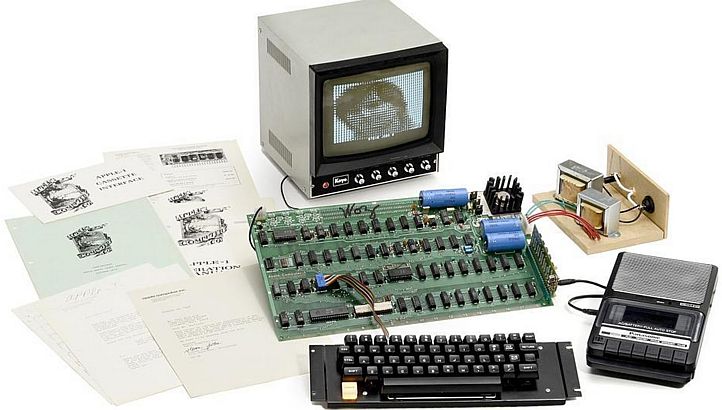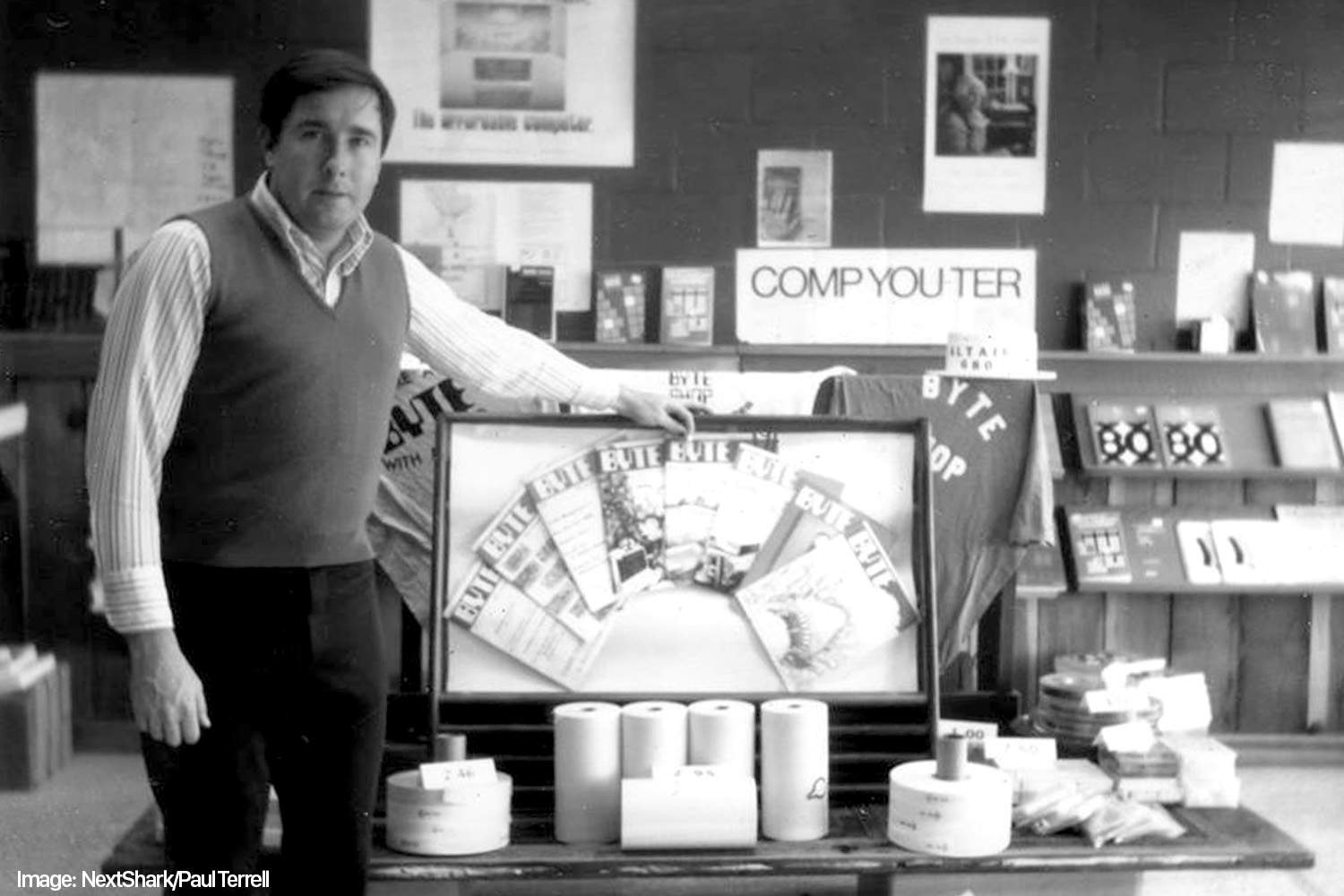 December 8, 1975: San Francisco Bay Area entrepreneur Paul Terrell opens the Byte Shop, one of the world’s first computer stores — and the first to sell an Apple computer.
December 8, 1975: San Francisco Bay Area entrepreneur Paul Terrell opens the Byte Shop, one of the world’s first computer stores — and the first to sell an Apple computer.
Years before Apple would open its own retail outlets, the Byte Shop stocks the first 50 Apple-1 computers built by Steve Jobs and Steve Wozniak.
The Byte Shop computer store: A stroke of genius
Today, the idea of selling computers in a store makes perfect sense. Add some eye-catching architecture and a clean, luxury-goods-inspired layout, and you have the template that allowed Apple’s stores to become the most profitable retail outlets on a square-foot basis by 2014.
But back in the 1970s, things certainly weren’t so straightforward. This was a time when personal computers were geeky, hobbyist projects that came in DIY kits. Apple co-founder Wozniak seriously considered giving away blueprints for his nascent Apple computer so anyone with enough patience could build one.
Paul Terrell thought differently. Modeling his business on Radio Shack, he opened his first Byte Shop in Mountain View, California, on this day in 1975. By the end of 1976, he had successfully expanded to 58 stores.
Unfortunately, he ran into problems that year. The most popular personal computer at the time was the Altair 8800. It kick-started the boom in personal computers and inspired a generation of techies. In fact, Terrell’s success pushing the Altair as an independent salesman was what convinced him to open a physical store in the first place.
However, his decision to stock other products at the Byte Shop in addition to the Altair resulted in MITS (the company behind the computer) pulling Terrell’s dealership status for the machines. And that led him to the Steves and Apple.
The Byte Shop takes a chance on Apple-1

Photo: Auction Team Breker
Looking around for a computer he could sell at the Byte Shop, Terrell met with Jobs, who came into the store trying to sell him on the Apple-1. Terrell knew of Jobs through the Homebrew Computer Club, a local hobbyist group that met regularly, but had never spoken with him.
At first, Terrell wasn’t convinced. He found Jobs very intense. And while the Apple-1 was certainly a functional computer, it was one of numerous such machines making the rounds.
The retailer rejected Jobs’ suggestion that he sell Apple-1 computers in kit form for buyers to put together themselves. Instead, Terrell told Jobs that — with computers becoming more mainstream — Byte Shop customers wanted to buy fully assembled machines.
Jobs listened and agreed. Terrell said he would buy 50 Apple-1 computers for $500 each, although cash would only be paid on delivery.
Terrell marked up the computers to $666.66, or the equivalent of $3,787 today. Anyone who bought and kept one, however, is in luck: Surviving Apple-1 units routinely sell for hundreds of thousands of dollars now. (Or at least they do as routinely as is possible for a computer with only a handful of existing units.)
Paul Terrell: A big influence on Apple
Like so much about tech history, it seems obvious now that not everyone wants to build their own computer. Terrell’s insistence on selling the Apple-1 fully assembled at the Byte Shop shaped the direction of Apple and the PC industry as a whole.
However, the Apple-1 was an assembled computer in little more than name. It needed a power supply, keyboard and monitor, so it wasn’t exactly usable right out of the box. But Terrell’s guidance clearly influenced the creation of the Apple II. That resulted in the world’s first all-in-one personal computer targeting general consumers as well as techies.
Due to Terrell’s important role in Apple history, Wozniak referred to him as the “fourth Apple founder,” after himself, Jobs and early investor Ron Wayne. (Wayne sold his stake in Apple for just $800 — but that’s another story.)
Terrell wound up selling his Byte Shop chain in 1977. His influence on the personal computer industry wasn’t over, though. Later on, he helped pioneer the rental business model for personal computers (and software) with a new company called ComputerMania.
You might need to squint to see the connection. But to my mind, that doesn’t seem a million miles from the subscription-based “rental” model of distribution we now see with services like Apple Music and Apple TV.
Where did you buy your first personal computer? Leave your comments below.



6 responses to “Today in Apple history: The Byte Shop, Apple’s first retailer, opens”
Purchased a KayPro 2x for $1,980 in 1984. It came with a daisywheel printer which allowed me to get pass the HS English teacher who refused work submitted from computer dot-matrix printouts.
Late 1978, Apple ][ at the Los Altos Computerland. Had to rummage around some electrical fix-it shops to locate a small 12″ color TV and cassette recorder. Had to wait for months for the floppy drive. Floppy disks were incredibly expensive at $35 per box of ten and could barely contain 100k.
This isn’t correct. First Tech in Minneapolis was the worlds first Apple reseller. They even had Apple II demo unit 3. Sadly, they closed in 2014.
Byte Shop Mt. View bought the first 50 Apple 1 Computers from Steve Jobs and Woz before Apple was a company and as Woz has since said ” My purchase Order for $25,000 or 50 Apple 1 Computers was the defining moment for the creation of Apple Computer because that was the moment that they quit their day jobs at HP and Atari and started their own company.
Many Computer Store retailers were to follow and many customers later that company has become the most successful in the world. Long Live Apple Computer!
First computer was a Leading Edge in 1986. Cost me $1,200 with a green screen monitor. Reason I bought it was that the company I worked at was providing AutoCAD 2.1 for $100 to its engineer to buy and use at home.
The Leading Edge came with two 5-1/4″ floppies. Remember when I booted up AutoCAD for the first time and loaded the Columbia drawing. It took 12 minutes to load!!! I ran back to the computer store and dropped another $300 for a 8088 co-processor. Now the Columbia took just 17 seconds to load.
The next paycheck I bought a Hercules HardCard (a 25mb hard drive on a card) for another $300 and dropped that bad-boy into the box. Next a dot-metic printer and within 2 months was doing AutoCad drawings and printing them for small manufacturing companies around the area. Payoff the system within 3 months.
Make a long story, I was making more money at home, with my AutoCAD business, that I left my day job. As they say the rest is history.
I saw the Apple ][ first at the Tucson Byte Shop. I realized it could do most of what the IBM 360 I worked with at my job, so I started plotting how to justify and pay for one. I found a software engineer in the Bay Area that wrote a program for the Apple to run his wife’s food supplement MLM business, which I was in, too. Soon I bought an Apple ][ with a 156k floppy drive and an RF Modulator so I could use a TV as a monitor. I think I paid S2300.00 at the local ComputerLand.